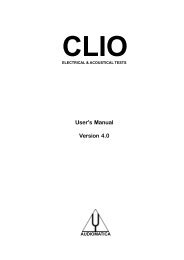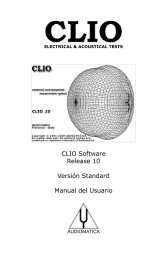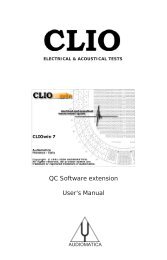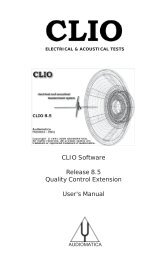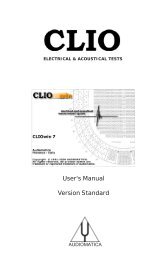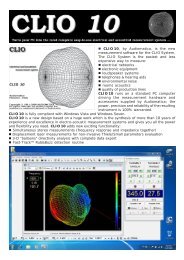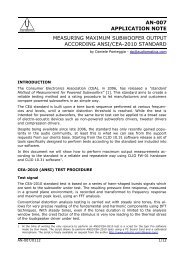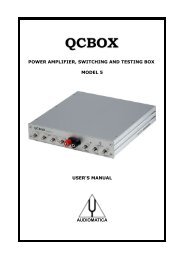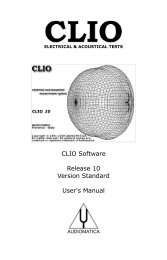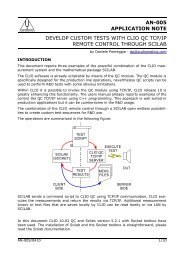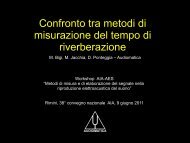CLIOwin 6.5 PCI User's Manual - Audiomatica Srl
CLIOwin 6.5 PCI User's Manual - Audiomatica Srl
CLIOwin 6.5 PCI User's Manual - Audiomatica Srl
Create successful ePaper yourself
Turn your PDF publications into a flip-book with our unique Google optimized e-Paper software.
11.4 DISTORTION AND SETTINGS<br />
Sinusoidal stimuli allows CLIO to evaluated distortion in its single harmonic contribution.<br />
If not Set in Impedance Mode, CLIO always evaluate harmonics from second to fifth and<br />
allows display each one separately via its own push buttons. While it is straight to have<br />
meaningful distortion figure of electrical devices, measuring Loudspeaker distortion, in<br />
normal environments (without anechoic chamber) is not trivial. We will give only some<br />
advise here, relaying on examples, as the topic is far beyond the scope of this User<br />
<strong>Manual</strong>. To do this we will use CLIO’s FFT Menu in quite an advanced way. Distortion<br />
evaluation is adversely affected by several parameters; Two are the most important.<br />
Noise<br />
50 dBSPL of ambience noise, a common figure, usually does not affect Amplitude<br />
evaluation which is usually carried out at an average level of 90dBSPL. This is<br />
particularly true using CLIO Sinusoidal Analysis capability which, by means of DSP<br />
filtering, allows exceptional S/N Ratio. Unfortunately evaluating 1% distortion<br />
means looking for signals that are 40dB lower than the 90dBSPL mentioned above,<br />
in the same magnitude order of environment noise.<br />
Gating Effects<br />
Device settling time, not perfect delay removal and reflections arriving within the<br />
sampling time (Meter On) seriously affect distortion measurements, creating<br />
artifacts.<br />
It is advisable to perform a noise evaluation using FFT Analysis. Fig.9 shows two curves,<br />
the first (red) is obtained with the Max Hold function, the second (black) with Min Hold.<br />
80.0<br />
CLIO<br />
dBSPL<br />
60.0<br />
40.0<br />
20.0<br />
0.0<br />
-20.0<br />
20 100 1k Hz<br />
10k 20k<br />
Figure 11.8<br />
The first, a sort of worst case, should be taken as the reference lower distortion floor<br />
once risen 10dB at least. The second is useful to identify pure tones in the noise<br />
spectrum; these are likely to produce both distortion increase as well as cancellation<br />
artifacts. In our case this tones are caused by more than 20 different computer fans,<br />
spread everywhere in the room. Supposing we carry a distortion analysis at an average<br />
90dBSPL, residues below 1% are difficult to evaluate up to 600Hz, things going much<br />
better at higher frequencies. Remember that the frequency axis should be referred to<br />
the harmonic we are looking for, not to the fundamental. The obvious solution to<br />
overcome noise is increase level. One way is to put more voltage at the Loudspeaker<br />
terminals; unfortunately this increase distortion by its own even if it provide important<br />
information regarding the device. The second way is to narrow the Microphone to<br />
Loudspeaker distance. The next figures, dealing with Gating Effects, refer to a<br />
114 Chapter 11 - Sinusoidal



